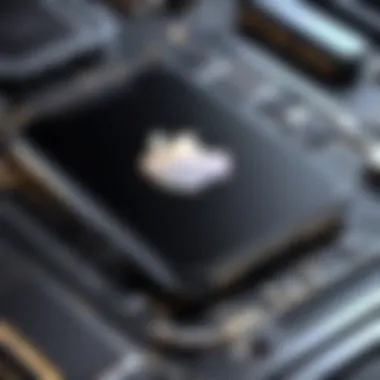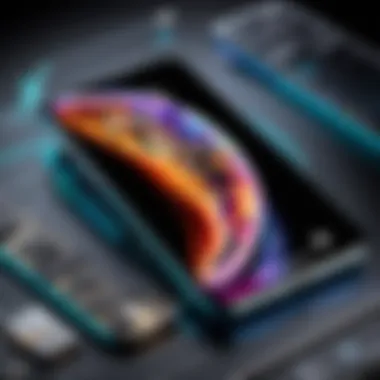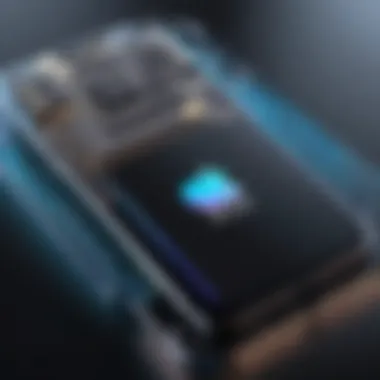Understanding iPhone Compatibility with 5G Technology


Intro
As the deployment of 5G technology continues to expand globally, understanding which devices are compatible becomes increasingly important. The iPhone lineup has seen significant advancements over the years, leading to the integration of 5G connectivity. This section delves into the key aspects of iPhone models that support 5G, the performance metrics associated with this technology, and the overall user experience.
In this article, readers will find valuable insights into the evolution of Apple's approach to wireless technology, particularly 5G. Additionally, we will examine how iPhone users can benefit from enhanced speed and performance. For IT professionals and tech enthusiasts, being informed about these developments ensures that they stay ahead in the fast-evolving landscape of mobile technology.
To set the stage, we will begin with a discussion on performance metrics.
Performance Metrics
5G technology promises significantly improved performance metrics compared to its predecessors. The metrics focus on aspects such as speed, responsiveness, and overall network performance. Here, we will explore these factors in detail.
Benchmarking results
Benchmarking is crucial to evaluating the real-world performance of 5G capable iPhones. Users can expect download speeds that potentially reach up to 10 gigabits per second, depending on network conditions. Key findings from recent benchmarks highlight:
- Increased download speeds: Up to 10 times faster than 4G LTE.
- Lower latency: Reduced response time enhances real-time communication.
- Improved capacity: More devices can connect without affecting performance.
These results indicate that 5G is a substantial leap forward in mobile connectivity.
Speed and responsiveness
The responsiveness of a device is just as vital as its speed. The iPhone models that support 5G, such as the iPhone 12, iPhone 13, and iPhone 14 series, showcase significant improvements in how users interact with applications and content.
- Instant loading times: Applications load approximately 20% faster.
- Enhanced streaming quality: Higher bandwidth allows for smoother video streaming.
- Real-time interactions: Gaming and video calls benefit from lowered latency, enhancing the user’s experience.
This advancement is not just a technical upgrade; it transforms how users engage with their devices, increasing efficiency and satisfaction.
"With the integration of 5G, the iPhone is no longer just a communication device; it's a powerful medium for applications that require real-time data."
Usability and User Experience
Beyond performance metrics, the usability and user experience of 5G-capable iPhones are essential for consumer adoption. The endeavor to make 5G accessible and easy to use significantly influences user satisfaction.
Ease of installation and setup
Setting up 5G on an iPhone is straightforward. Users need to ensure that they are connected to a compatible 5G network. The settings prompt users to activate 5G connectivity, which usually requires no intricate technical knowledge. The process can be summarized as follows:
- Go to Settings.
- Tap on Cellular.
- Select Cellular Data Options.
- Tap on Voice & Data.
- Choose 5G On.
This simplicity supports users, whether they are tech-savvy or less experienced.
Interface design and navigation
Apple's interface design emphasizes intuitive navigation, and this extends to 5G functionalities. As users switch to 5G, they will find that the interface remains consistent with prior models. Key features facilitate smooth navigation:
- Seamless transitions: Users can switch between 4G and 5G without experiencing interruptions.
- Status indicators: Clear indicators show when the device is connected to 5G.
- User guidance: Information pop-ups assist in understanding new options related to 5G settings.


These design choices enhance user experience overall, allowing individuals to navigate more efficiently while using their devices.
Preface to 5G Technology
The emergence of 5G technology marks a significant chapter in mobile communication. It offers high-speed connectivity and increased bandwidth. Understanding 5G is essential for users wanting to leverage its benefits fully. The relevance of this topic grows as more devices, including iPhones, are designed to utilize 5G capabilities. This analysis delves into what 5G is and highlights its implications for mobile phone users, especially iPhone owners.
Overview of 5G
5G, short for fifth generation, is the latest standard for cellular networks. It is built upon the foundations of previous generations, enhancing speed and connectivity. A fundamental characteristic of 5G is its ability to transmit data more quickly than 4G LTE. Typical download speeds can reach up to 10 Gbps, substantially exceeding current standards.
This technology uses various frequency bands, including low-band, mid-band, and high-band or mmWave. Each band offers different speeds and coverage areas. Low-band provides broad coverage similar to 4G, while mmWave delivers the fastest speeds but with limited range. The versatility of these bands allows for various applications, making 5G adaptable to different environments.
Moreover, 5G networks support a larger number of simultaneously connected devices. This is crucial in urban areas where demand for mobile data is increasing. As cities become smarter and more connected, 5G plays a vital role in supporting Internet of Things (IoT) devices, autonomous vehicles, and more.
Benefits of 5G for Mobile Users
Mobile users stand to gain immensely from the implementation of 5G technology. Here are some of the key benefits:
- Faster Data Speeds: 5G significantly reduces download and upload times. This means quicker streaming, faster downloads, and a smoother online experience.
- Improved Latency: Lower latency translates to real-time responsiveness. This is particularly valuable for gaming, video conferencing, and augmented reality applications.
- Enhanced Capacity: As mentioned earlier, 5G accommodates more devices on the network. This feature is essential for densely populated areas, ensuring everyone can connect without degradation of service.
- Energy Efficiency: 5G technology is designed to be more energy-efficient than previous generations. This benefits both users and network providers in terms of operational costs and sustainability.
- New Use Cases: The technology opens doors for innovations in various fields such as telemedicine, smart cities, and connected vehicles. This can lead to improved quality of life and productivity.
"5G's advancement signals a transformative period in mobile technology, shaping the future of connectivity."
iPhone Evolution and 5G Integration
The evolution of iPhone technology has been pivotal in reshaping user experiences and setting new standards in the mobile communications sector. As 5G technology becomes mainstream, understanding how iPhones integrate with its capabilities is crucial for consumers and professionals alike. The transition to 5G entails not just faster download speeds but also improvements in latency, connectivity, and overall performance. As such, iPhone models capable of harnessing these enhancements can significantly change how we interact with apps, engage in video conferencing, and stream high-definition content.
Historical Context of iPhones and Connectivity
From the launch of the original iPhone in 2007 to the latest models, Apple has consistently pushed technological boundaries. The original iPhone operated on 2G networks, limiting internet speeds and connectivity. Subsequent introductions of 3G and 4G LTE marked major milestones. The 3G enabled mobile internet access, while 4G LTE delivered better speeds and more reliable connections. Each evolution catered to the increasing demand for higher data usage among consumers. By retracing Apple's steps, we can appreciate the gradual progression toward 5G.
Early models, such as the iPhone 3G, showcased the functional potential of mobile internet. The introduction of LTE with the iPhone 5 in 2012 marked a significant leap, paving the way for the adoption of data-heavy applications. The timeline of iPhone models reflects broader trends in telecommunications, aligning with advancements in network technologies. This progression emphasizes the importance of keeping up with connectivity standards as they evolve.
Technological Advancements Leading to 5G
The move to 5G is not merely an incremental upgrade; it is a transformation rooted in several technological advancements. Enhanced capacity, lower latency, and improved power efficiency are key features of 5G that distinguish it from prior generations. 5G architecture involves more efficient spectrum utilization, which allows more devices to connect simultaneously without degradation of service.
Several components contribute to the integration of 5G in iPhones. These include:
- Advanced Chipsets: Apple’s A14 Bionic chip and subsequent models incorporate hardware specifically designed to support 5G connectivity.
- Modem Technology: The transition to 5G required innovative modem technologies. The integration of Qualcomm’s X55 modem in supported iPhones has dramatically improved performance.
- Network Infrastructure: The rollout of 5G networks across various regions has impacted how consumers will utilize the latest iPhones.
iPhone Models with 5G Capabilities
The ability of iPhone models to support 5G technology holds significant relevance as mobile networks evolve. With the transition from 4G to 5G, users access faster speeds, lower latency, and improved reliability. Understanding which iPhones are equipped for 5G enhances knowledge for tech-savvy consumers and IT professionals alike.
As 5G becomes increasingly integrated into daily life, it is essential to identify which iPhone models are compatible. This compatibility can influence the overall user experience and drive consumers' decision when purchasing or upgrading their devices.
iPhone Models Supporting 5G Enhancements
iPhone Series


The iPhone 12 Series marks Apple's initial venture into the 5G realm. With the introduction of this series, users experienced a leap in mobile connectivity. One of the key characteristics of the iPhone 12 models is their inclusion of a powerful A14 Bionic chip. This feature not only enhances processing power but also optimizes 5G performance, allowing users to stream content and download files rapidly.
A notable unique feature of the iPhone 12 Series is its compatibility with both sub-6 GHz and mmWave 5G networks. This capability ensures users can access 5G in urban areas, where mmWave technology thrives, providing even higher speeds. While the benefits are clear, users should also consider the battery consumption associated with 5G use. In demanding situations, the battery may drain faster than on older models operating on 4G.
iPhone Series
Building on its predecessor, the iPhone 13 Series further refines 5G capabilities. The key characteristic of these models lies in an enhanced battery life, which addresses concerns about energy consumption while using 5G. Enhanced My5G technology allows for smarter power management, enabling users to experience extended connectivity without frequent recharging.
A unique aspect of the iPhone 13 is its ability to maintain connectivity even in challenging environments. This alleviates some common issues users faced with 5G era, such as dropped signals. While the iPhone 13 offers impressive 5G features, it's necessary to note that 5G speeds can still be affected by network conditions and congestion.
iPhone Series
The iPhone 14 Series makes further advancements by introducing improved antenna technology, supporting even greater 5G connectivity. The main benefit of this series is its reliability in maintaining connections under various conditions, which enhances the overall user experience significantly.
In addition to enhanced connectivity, the iPhone 14 models introduce new software features that optimize 5G performance for specific applications like gaming and streaming. This targeted approach to 5G functionality sets the iPhone 14 apart as an ideal choice for users seeking a premium mobile experience. However, as with all advancements, users may need to consider the cost and investment associated with higher-end models.
iPhone SE (3rd Generation)
The iPhone SE (3rd Generation) provides an interesting entry point for those seeking 5G capabilities without the premium price tag. This model features the A15 Bionic chip, linking it closely to the performance seen in flagship phones. Notably, its compact design makes it a popular choice among users who prefer smaller devices without compromising connectivity.
The iPhone SE’s unique feature is its affordability, making it accessible to a broader user base interested in experiencing 5G. It offers fundamental advantages like speed enhancements for everyday tasks, but it may not have the advanced components found in premium models, such as advanced camera systems or high-resolution displays. Nonetheless, it remains a practical option for many users wanting to step into the 5G era.
Comparative Analysis of 5G Performance
To fully appreciate the 5G capabilities, it is crucial to analyze the performance differences across models. The variances in design, chip technology, and network compatibility can significantly influence user experience. By understanding these distinctions, consumers make informed choices about which iPhone best suits their needs for embracing 5G.
How to Enable 5G on iPhones
Enabling 5G on an iPhone is essential for users who wish to harness the full potential of their devices in today’s fast-paced digital environment. With mobile applications demanding higher bandwidth and lower latency, understanding how to activate 5G can significantly affect user experience. This section provides clear guidance on configurations needed for effective 5G usage and outlines the requirements of the accompanying data plans.
Settings Configuration for 5G Usage
To make the most of 5G, users must first check their settings. The process is relatively straightforward:
- Open Settings: Navigate to the Settings app on your iPhone.
- Cellular: Tap on the Cellular option.
- Cellular Data Options: Select the Cellular Data Options section.
- Voice and Data: Here, users will see options for 5G. It can be set to one of three configurations:
- 5G On: This option ensures that 5G will always be the preferred connection when available.
- 5G Auto: This allows the iPhone to switch between 5G and LTE based on the requirements of various applications, conserving battery life.
- LTE: Selecting this means that the device will not utilize 5G at all, which may limit the speed but help with battery preservation.
Proper settings offer real improvement in speed and reliability. Users should regularly ensure their settings reflect their desired connection type.
Data Plan Requirements for 5G
Not only do iPhone users need to configure settings for 5G access, but they also require an appropriate data plan. Here are some key factors:
- Carrier Support: Users must choose a carrier that supports 5G network access. Major telecom companies like Verizon, AT&T, and T-Mobile have various 5G plans available.
- Unlimited vs. Limited Plans: While unlimited data plans may provide peace of mind, it's important to check if any throttling applies once certain data usage thresholds are met. Limited plans could restrict usage, especially with high data applications.
- 5G-Specific Plans: Some providers have plans tailored specifically for 5G usage, which may offer additional benefits.
By ensuring the correct plan, users can fully experience the enhanced speed and capabilities provided by 5G without unexpected interruptions or fees.
Real-World Implications of 5G for iPhone Users


The introduction of 5G technology marks a significant development in mobile connectivity. For iPhone users, this evolution brings both opportunities and challenges. Understanding these implications is essential. With faster speeds, lower latency, and improved capacity, 5G networks can enhance the way users communicate, work, and access information. This section analyzes how these advancements affect daily interactions with technology.
Impact of 5G on User Experience
5G technology fundamentally transforms user experience across various dimensions. First, loading times for applications are drastically reduced. Tasks like downloading large files or streaming high-definition videos happen in seconds rather than minutes. This immediacy can change how users consume content, making it more appealing and accessible.
Moreover, gaming experiences are elevated with 5G. The reduced lag can enhance competitive gaming, providing smooth interactions and improved performance. This aspect is crucial for serious gamers who rely on responsive performance. Additionally, with the rise of augmented reality (AR) and virtual reality (VR) applications, 5G enables more engaging experiences. Users can participate in high-quality, real-time, immersive experiences that were previously limited by slower networks.
Another notable advantage is the improvement in video conferencing. With 5G, video calls are more stable and clearer, allowing for better remote collaboration. This is particularly relevant in the current work environment where many people depend on virtual communication.
Potential Challenges with 5G Connectivity
Despite the advantages, 5G technology introduces several potential challenges that users must consider. One significant issue is inconsistent coverage. While major cities may have extensive 5G networks, rural areas often still depend on slower 4G connections. Users in less populated areas might not experience the promised speed and reliability of 5G, potentially leading to frustration.
Security also becomes a concern with the widespread adoption of 5G. The increase in connected devices means larger attack surfaces for potential cyber threats. Users need to be vigilant about their data security. Furthermore, as more devices connect to the internet, the strain on infrastructure can lead to congestion issues. During peak times, users may not experience the full benefits of 5G.
"While 5G presents significant opportunities, it also brings forth new challenges that users must navigate carefully."
In addition, the costs associated with upgrading to a 5G compatible device and acquiring 5G data plans may not appeal to every user. For some, the expense may outweigh the benefits if they do not require the enhanced capabilities of 5G.
In summary, the real-world implications of 5G for iPhone users are multifaceted. While the benefits are compelling, users must also remain aware of the challenges that accompany this technology.
Future of 5G and iPhone Technology
The future of 5G represents a significant shift in how mobile technology integrates into daily life. As iPhones evolve, their compatibility with 5G will become increasingly crucial. This section underscores the importance of understanding these developments. 5G brings enhanced speed, reduced latency, and improved capacity. It will allow iPhones to support more advanced applications and services. Therefore, keeping pace with these changes is vital for IT professionals and tech enthusiasts alike.
Anticipated Improvements in iPhone Designs
As we look ahead, anticipated improvements in iPhone designs will be directly influenced by 5G technology. Future models may include lightweight materials, fostering increased battery efficiency as well as improved networks for connectivity. Additionally, manufacturers might explore more compact components to fully utilize the bandwidth provided by 5G. This means potential advancements in camera technology, augmented reality features, and even better user interfaces. All these factors contribute to a more enriching user experience.
- Battery Life: With new designs, one might expect better energy management for prolonged 5G usage.
- Camera Capabilities: Faster data transmission may support higher resolution videos and images.
- User Interface: Intuitive designs may emerge to better presents the capabilities of 5G applications.
Role of 5G in Future Mobile Applications
5G is poised to play a transformative role in mobile applications. Faster data speeds will empower developers to create more complex and responsive applications. This aspect will benefit sectors like gaming, healthcare, and education. Real-time data processing and augmented reality functionalities will likely become standard. 5G allows for seamless experiences across various applications, paving the way for innovation.
"The integration of 5G in mobile applications is not just an upgrade, but a transition into a new era of connectivity and user experiences."
Furthermore, applications relying on Internet of Things (IoT) will thrive, as 5G can handle higher volumes of connected devices. Users will experience smarter homes and more efficient workflows. The clear implication is that understanding and adapting to these changes is essential for both developers and users.
Summary and Finale
Recap of Key Points
Throughout this article, the following key points were discussed:
- 5G Overview: 5G is more than just a faster network; it represents a shift in how mobile technology functions. It's characterized by higher speeds, lower latency, and the ability to connect more devices seamlessly.
- iPhone Model Evolution: iPhones have continuously adapted to emerging technologies. Starting from the initial models, significant enhancements over successive generations have paved the way for 5G integration.
- Models with 5G Capabilities: The iPhone 12 series, iPhone 13 series, and iPhone 14 series, along with the iPhone SE (3rd generation), are all equipped to utilize 5G networks effectively.
- Configuration for 5G: Proper settings and data plan requirements are necessary for users to fully benefit from 5G capabilities.
- Real-World Implications: The transition to 5G brings potential changes to user experience, enhancing speed and connectivity but also introducing challenges that need addressing.
- Future of 5G and iPhones: Anticipated advancements in iPhone design and the role of 5G in new mobile applications indicate a transformative future for both iPhones and mobile technology.
Final Thoughts on iPhones and 5G
As we look forward to continued advancements, the importance of understanding how different iPhone models work with 5G cannot be overstated. For IT professionals and tech enthusiasts, being informed about these technologies opens opportunities. It allows users to make informed decisions about upgrading and utilizing the latest features effectively.
Ultimately, 5G technology is set to redefine mobile interactions, and iPhone users are at the forefront of this revolution. Staying updated on compatibility ensures users harness the full potential of both their devices and the evolving network landscape.
"As mobile technology continues to advance, the integration of 5G within everyday devices like the iPhone symbolizes a significant leap toward future simplicity and efficiency."



